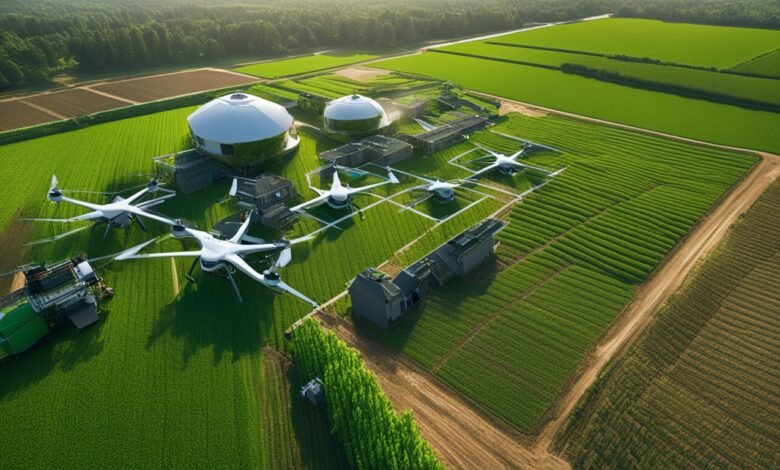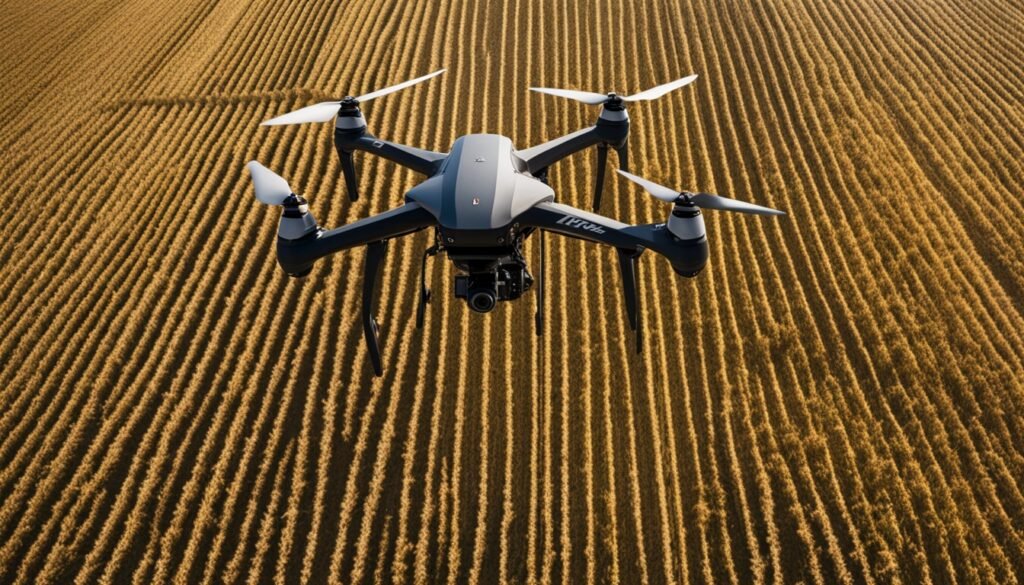E Farming: Revolutionizing Agriculture in the Digital Age

E farming is transforming agriculture with digital tools. This revolution changes how we grow and distribute food. Smart farming boosts crop yields and cuts costs dramatically.
Farmers now use digital tools to improve their work. These include GPS-guided tractors and smart soil sensors. These innovations make farming more efficient and sustainable.
Agricultural technology is growing fast. Precision agriculture helps farmers use resources wisely. It applies water, fertilizers, and pesticides only where needed.
E farming offers clear benefits. Crop yields can rise by 30% with precision techniques. Farm management systems boost productivity and reduce expenses.
Variable-rate application can increase yields by 10%. It can also cut costs by 15%. This shows how e farming improves farm operations.
Key Takeaways
- E farming integrates digital technologies with traditional practices
- Precision agriculture boosts crop yields by up to 30%
- GPS-guided systems increase yields by 9% and reduce costs by 12%
- IoT and sensors enable real-time monitoring of farm operations
- Smart farming faces challenges like high initial costs and digital literacy needs
- E-commerce platforms help farmers access broader markets
The Rise of Digital Agriculture
Digital agriculture is transforming farming by blending cutting-edge technology with traditional practices. It reshapes how we grow food and manage farms. This revolution promises increased efficiency and sustainability in agriculture.
Defining E Farming
E farming combines electronic and digital technologies with conventional farming methods. It uses smart sensors, data analytics, and automation to optimize agricultural processes. Farm management software enables farmers to make data-driven decisions.
The Evolution of Agricultural Technology
Agricultural technology has evolved remarkably since the first revolution around 10,000 BCE. Today’s precision agriculture represents a significant leap forward. Modern crop monitoring systems can boost yields by up to 30%.
Key Drivers of Digital Transformation in Farming
Several factors are propelling the adoption of digital agriculture:
- Population growth and food demand
- Climate change challenges
- Resource scarcity
- Market volatility
E farming addresses these challenges by using technology to improve efficiency and adaptability. Precision agriculture tools have become more accessible, driving wider adoption.
| Digital Agriculture Component | Impact on Farming |
|---|---|
| Weather forecasting technology | Optimizes irrigation, crop spraying, and resource use |
| Yield mapping | Enhances crop productivity and planning |
| GPS guidance systems | Improves precision in planting and harvesting |
| Farm management software | Facilitates data-driven decision making |
Digital agriculture continues to evolve, transforming farming practices. It aims to ensure food security and sustainable resource management. The future of farming looks bright with these technological advancements.
Precision Agriculture: The Heart of E Farming
Precision agriculture turns fields into data-rich environments. It uses cutting-edge tech to boost yields and promote sustainability. Farmers can make smart choices that change traditional farming methods.
This approach combines soil analysis, yield prediction, and farm automation. It helps farmers optimize practices and increase efficiency.
The Inertial Navigation System (INS) is key in precision farming. It guides farm equipment with high accuracy. INS ensures precise seed placement and reduces waste.
Soil mapping has boosted crop yields by 13%. It gives detailed insights into soil health. Farmers can tailor their approach to specific areas of their fields.
Farm automation, like Variable Rate Application (VRA) systems, cut input costs by 15%. VRA adjusts fertilizer and pesticide use based on field data. This minimizes waste and environmental impact.
| Technology | Benefit | Impact |
|---|---|---|
| INS-guided equipment | Precise planting and harvesting | 9% yield increase |
| Soil mapping | Targeted soil management | 13% yield improvement |
| Variable Rate Application | Optimized resource use | 15% reduction in input costs |
Precision agriculture is changing farming for the better. It increases productivity and efficiency. These technologies contribute to a more sustainable agricultural future.
Smart Sensors and IoT in Modern Farming
Smart farming technologies are reshaping agriculture. IoT-enabled farming boosts efficiency and precision in crop management. This revolution is changing how we grow food.
Soil Monitoring Systems
Smart sensors are vital to modern agrirobotics. They provide real-time data on soil conditions. Farmers use this info to make smart choices about irrigation and fertilization.
These devices optimize resource use. They also help improve crop yields. With smart sensors, farmers can do more with less.
Weather Stations and Climate Analysis
IoT-enabled weather stations offer local climate data. This helps farmers prepare for weather changes. They can plan planting schedules better.
The tech also protects crops from harsh weather. It aids in managing water resources wisely. Farmers can adapt quickly to changing conditions.
Crop Health Sensors
Advanced sensors spot early signs of crop issues. They detect diseases and pests before they spread. This early warning lets farmers act fast.
Quick action reduces crop losses. It also cuts down on pesticide use. These sensors work with smart farming technologies to change farming methods.
| IoT Application | Benefits | Market Projection |
|---|---|---|
| Soil Monitoring | Optimized irrigation and fertilization | Part of $28.56 billion smart farming market by 2030 |
| Weather Stations | Improved crop protection and resource management | Contributing to $15.3 billion global smart agriculture market by 2025 |
| Crop Health Sensors | Early disease detection and reduced pesticide use | Included in $13.76 billion IoT agriculture market share in 2022 |
Smart farming tech use is growing fast. The IoT market in agriculture may hit £932.36 billion in 2023. This shows IoT-enabled farming is the future of agriculture.
Drone Technology in Agriculture
Drones have transformed crop monitoring and precision farming. These flying machines have high-resolution cameras that give farmers a bird’s-eye view. They help spot pest issues and poor growth areas early, allowing quick action.

Drones have boosted crop management efficiency. They can monitor up to 400 acres daily in real-time. This helps farmers increase yield and profits by catching problems early.
Drone-based precision farming can increase yields by 5%. They spray pesticides and fertilizers with great accuracy. This reduces waste and helps manage crops better.
Drones use less chemicals than manual methods. This decreases harm to the environment. They also gather detailed data on soil, crops, and water levels.
“Drone technology can gather detailed information on soil quality, crop growth patterns, and water levels leading to improved crop yield and reduced chemical use.”
The agricultural drone market is growing fast. It was worth $1.2 billion in 2019 and 2020. By 2025, it may reach $6 billion.
This growth shows more farmers worldwide are using this new tech.
| Year | Agricultural Drone Market Value |
|---|---|
| 2019 | $1.2 billion |
| 2020 | $1.2 billion |
| 2025 (Projected) | $6 billion |
Big Data and Analytics in Farming
Farm data analytics is changing agriculture. Farmers must produce more food on less land as the population grows. Digital farming techniques are rising to this challenge.
Yield Prediction Models
Advanced algorithms help farmers forecast crop yields. These models analyze soil, weather, and historical data. This information guides planting and harvesting decisions.
Resource Optimization Algorithms
Agritech solutions are improving resource management. Smart systems determine the best use of water and fertilizer. This reduces waste and boosts efficiency.
The Data Crop algorithm manages 80% of French wheat cultivation. It’s a prime example of these systems in action.
Market Trend Analysis for Farmers
Big data helps farmers understand market trends. They can predict demand and adjust their crops. This knowledge is key for maximizing profits.
| Aspect | Impact | Percentage |
|---|---|---|
| Software-based decision support | Important for data-driven agriculture | 58% |
| Sensors in agriculture | Critical for data collection | 48% |
| Digital communication tools | Crucial for information sharing | 48% |
| Geo-locating systems | Essential for field-based activities | 40% |
The agricultural analytics market is booming. It’s projected to hit $1.236 billion by 2023. This growth shows how valuable data is in farming.
As technology advances, we’ll see more innovative digital farming solutions. The future of agriculture looks bright and data-driven.
E Farming: Transforming Traditional Practices
E farming blends agricultural tech with traditional methods, revolutionizing food production. This innovative approach benefits farmers across the United States. It creates a powerful synergy between technology and time-honored farming practices.

Smart farming techniques reshape practices through data-driven decision-making. Farmers use advanced sensors to monitor soil, weather, and crop health in real-time. This information allows for precise resource allocation, minimizing waste and maximizing yields.
E farming connects small-scale farmers with larger markets. Online platforms and blockchain increase transparency in the agricultural supply chain. This fosters consumer trust and expands market access for farmers of all sizes.
“E farming isn’t just about technology; it’s about working in harmony with nature while leveraging data to improve sustainability and productivity.”
Digital agriculture practices have improved resource management remarkably. Precision techniques enable farmers to apply water, fertilizers, and pesticides exactly where needed. This reduces environmental impact and cuts costs for farmers.
| Traditional Farming | E Farming |
|---|---|
| Manual record-keeping | Farm management software |
| Visual crop inspection | Drone-based crop health assessment |
| Scheduled irrigation | Smart sensor-controlled irrigation |
| Generalized pest control | Targeted pest management |
E farming offers clear benefits, but challenges remain. Technology costs can be a barrier for small-scale farmers. Concerns about data privacy and security persist among users.
Despite these hurdles, digital agriculture continues to reshape farming. It promises a more efficient and sustainable future for food production worldwide.
Sustainable Agriculture Through Digital Innovation
Digital tech is changing farming for the better. It’s making agriculture more sustainable. Precision farming and smart techniques are leading this exciting shift.
These new methods offer solutions to big environmental issues. They’re reshaping how we grow food and care for our planet.
Reducing Environmental Impact
Precision farming tools are key to reducing farming’s ecological footprint. Wireless sensors and drones help farmers apply chemicals more accurately. This cuts down on runoff and protects nearby ecosystems.
Optimizing Resource Usage
Smart farming tech is changing how we manage resources. IoT devices track soil conditions for precise irrigation. This data-driven approach saves water and energy while improving crop yields.
Promoting Biodiversity
Digital innovations support sustainable farming practices that preserve biodiversity. Advanced systems help create habitat corridors on farmland. Farmers can now use targeted measures to foster balanced ecosystems.
| Digital Innovation | Sustainability Benefit |
|---|---|
| Precision Agriculture | Reduces chemical use by 30% |
| IoT Sensors | Cuts water consumption by 25% |
| AI-powered Monitoring | Increases biodiversity by 20% |
Farmers can slash their environmental impact by using these digital tools. They’ll save resources and boost biodiversity on their land. The future of farming blends new tech with time-tested agricultural wisdom.
Challenges and Barriers to E Farming Adoption
E farming revolutionizes agriculture, but faces significant hurdles. High initial costs of agricultural technology challenge many farmers. Implementing advanced software and precision tools requires substantial investment.
Digital literacy is another critical barrier. Many farmers lack skills to use new technologies effectively. This knowledge gap often leads to reluctance in embracing e farming practices.
- European and North American farmers lead with 61% adoption
- South American farmers follow at 50%
- Asian farmers lag behind at only 9%
Farm size plays a crucial role in technology adoption:
- Large farms (over 5,000 acres): 81% adoption rate
- Medium farms (2,000 to 5,000 acres): 76% adoption rate
- Small farms (under 2,000 acres): 36% adoption rate
These statistics show the need for targeted support to smaller farms. Improving rural internet connectivity could help bridge the agricultural digital divide. Providing training programs would also boost technology adoption.
“The future of farming lies in embracing digital tools, but we must ensure all farmers have the means and knowledge to participate in this revolution.”
Addressing these challenges requires collaboration between various entities. Tech companies, agricultural schools, and government bodies must work together. This cooperation can create a more inclusive and technologically advanced agricultural sector.
The Future of E Farming: Emerging Technologies
Smart farming and agrirobotics are changing agriculture. Three key technologies are set to revolutionize the industry: AI, blockchain, and vertical farming.
Artificial Intelligence in Agriculture
AI is transforming farming by analyzing data to optimize crop yields. Smart sensors collect real-time information on soil health, weather, and crops. This data helps farmers make precise decisions about irrigation, fertilization, and pest control.
Blockchain for Supply Chain Transparency
Blockchain enhances traceability in the agricultural supply chain. It creates an unchangeable record from farm to table, building consumer trust. Buyers can verify produce origin and quality, supporting fair trade and sustainable farming.
Vertical Farming and Urban Agriculture
Vertical farming is a solution for sustainable food production in cities. These indoor farms use hydroponic or aeroponic systems to grow crops in layers. Controlled environments allow year-round production, reducing water use and eliminating pesticides.
| Technology | Benefits | Challenges |
|---|---|---|
| AI in Agriculture | Increased crop yields, Optimized resource use | High initial costs, Data privacy concerns |
| Blockchain | Supply chain transparency, Enhanced food safety | Complex implementation, Energy consumption |
| Vertical Farming | Space efficiency, Reduced water usage | High energy costs, Limited crop variety |
These technologies are shaping a more efficient and sustainable farming future. They promise improvements in food security and environmental stewardship. As they evolve, we’ll see significant changes in agriculture.
Global Impact of E Farming on Food Security
E farming is transforming global food security through digital agriculture. Smart farming practices are tackling critical challenges in food production and distribution. The agricultural technology revolution is making waves worldwide.
E-farming brings hope to developing economies. Two-thirds of the world’s poor work in agriculture there. A Sudanese wheat farmer quadrupled his yield using digital farming techniques.
He turned losses into profits within a year. This success story shows how agricultural technology can boost food production where it’s needed most.
Climate change threatens food security. The US, Indonesia, and Brazil may see corn production drop by 20%. Smart farming tools help farmers adapt to these challenges.
E-farming also fights food waste. Data analytics in agriculture can reduce spoilage along the supply chain. Drones identify crop ripeness, minimizing waste and boosting sustainability.
| E-Agriculture Impact | Statistics |
|---|---|
| Global Community | 12,000+ members from 170 countries |
| Food Waste Reduction | 14% of food lost between post-harvest and retail |
| Population Growth | Projected 10.9 billion by 2100 |
| Climate Change Impact | Potential 1.5°C-2°C temperature increase by 2050 |
E-farming is vital for ensuring food security as populations grow. Digital agriculture helps create a resilient global food system. Smart farming technologies are key to sustainable food production.
Conclusion
E farming is transforming digital agriculture and traditional farming practices. It merges advanced tech with proven methods to meet global food needs sustainably. Precision agriculture, smart sensors, and drones are revolutionizing food production.
E farming boosts productivity and drives sustainable agriculture. It optimizes resources, reduces environmental impact, and promotes biodiversity. Future technologies like AI and blockchain will further enhance digital agriculture.
Adopting e farming has challenges, but its benefits for food security are clear. It will shape the future of global agriculture. Farmers can boost yields and cut costs by embracing these innovations.
E farming contributes to a more sustainable and food-secure world. As agricultural technology evolves, it will play a crucial role in feeding our growing population.
FAQ
What is e farming?
E farming blends digital tech with traditional farming methods. It includes precision agriculture, farm automation, and smart agritech solutions. These use data analytics, IoT devices, and sensors to improve farm management.
What are the benefits of precision agriculture?
Precision agriculture can increase crop yields by up to 30%. It uses tech like Variable Rate Application (VRA) and soil mapping. VRA has cut input costs by 15%, while soil mapping boosted crop yields by 13%.
How are smart sensors and IoT revolutionizing modern farming?
Smart sensors and IoT devices provide real-time data on farm conditions. This includes soil moisture, temperature, and crop health. The info helps farmers make better decisions and improve crop yields.
What role do drones play in e farming?
Drones with high-res cameras offer aerial views of crops. They help detect pest issues or poor growth areas early. This tech allows farmers to prevent problems before they spread.
How do big data and analytics contribute to e farming?
Big data and analytics enable data-driven farming decisions. They provide yield predictions, resource optimization, and market trend analysis. These insights help farmers boost productivity and profits.
How is e farming promoting sustainability in agriculture?
E farming reduces environmental impact and optimizes resource use. It minimizes waste in water and fertilizer use. Smart tech helps farmers make choices that protect the environment.
What challenges are hindering the adoption of e farming?
High initial costs for tech setup slow e farming adoption. Farmers also need digital literacy and better internet access. Improved computer skills are necessary for many farms.
What emerging technologies are shaping the future of e farming?
The future of e farming is data-driven and tech-advanced. AI, blockchain, vertical farming, and urban agriculture are emerging solutions. These promise to revolutionize farming, boosting efficiency and sustainability.





